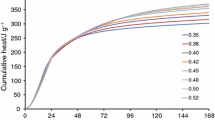Abstract
Different techniques for measuring heat of hydration of cement are discussed, and a sample holder designed specially for measuring isothermal heat of hydration is described. A particular characteristic of the sample holder is the vaccum mixing technique which ensures a momentary and homogeneous mixing of the water and the cement. This enables investigation of the rapid initial cement-water reactions. In addition, measurements at very low watercement ratios are made possible with this technique.
Résumé
On discute des différentes techniques pour mesurer la chaleur d'hydratation du ciment et on décrit un support conçu pour mesurer la chaleur isotherme d'hydratation. Ce support présente une caractérique spécifique qui est la technique de mélange sous vide qui assure un malaxage momentané et homogène de l'eau et du ciment, permettant ainsi l'investigation des réactions initiales ciment-eau. De plus, cette technique rend possible des mesures de la chaleur à de très faibles rapports ciment-eau.
Similar content being viewed by others
References
Freiesleben Hansen P., Lorentzen, B. and Nielsen, T., ‘E. Calvet Microcalorimeter’, (in Danish), Internal report No. 283 (Concrete Research Laboratory, Karlstrup, 1973).
Verbeck, G.J. and Foster, C.W., ‘Long-time study of cement performance on concrete with special reference to heats of hydration’, Bulletin No. 32, Portland Cement Association, 1949.
ASTM Committee C-1, ‘Standard test method for heat of hydration of hydraulic cement’, C 186-86, Annual book of ASTM Standards, Vol. 04.01: Cement, Lime, Gypsum, 1987, 188–195.
Forrester, J.A., ‘A conduction calorimeter for the study of cement hydration’,Cement Technology 1 (3) (1970) 95–99.
Aukett, P.N., and Bensted, J., ‘Application of heat flow calorimetry to the study of oilwell cements,Journal of Thermal Analysis 38 (1992) 701–707.
Ma, W., Sample, D., Martin, R. and Brown, P.W., ‘Calorimetric study of cement blends containing fly ash, silica fume, and slag at elevated temperatures’,Cement, Concrete, and Aggregates 16 (2) (1994) 93–99.
Bensted, J., ‘Some applications of conduction calorimetry to cement hydration,’Advances in Cement Research 1 (1) (1987) 35–44.
Mejhede Jensen, O., ‘The pozzolanic reaction of silica fume’ (in Danish), TR 229/90 (Building Materials Laboratory, Technical University of Denmark, 1990).
Waller, V., De Larrard F., and Roussel, P., ‘Modelling the temperature rise in massive HPC structures’ in ‘4th International Symposium on Utilization of High-Strength/High-Performance Concrete’, Proceedings RILEM, France, May 1996, 415–421.
Schaumann, J., ‘Absorption, of water of lignocellulose materials’, (in Danish), Serie R, No. 3 (Department of Structural Engineering and Materials, Technical University of Denmark, 1996).
Author information
Authors and Affiliations
Rights and permissions
About this article
Cite this article
Freiesleben Hansen, P., Mejlhede Jensen, O. A sample holder for the study of isothermal heat of hydration of cement. Mat. Struct. 31, 133–136 (1998). https://doi.org/10.1007/BF02486476
Received:
Accepted:
Issue Date:
DOI: https://doi.org/10.1007/BF02486476




